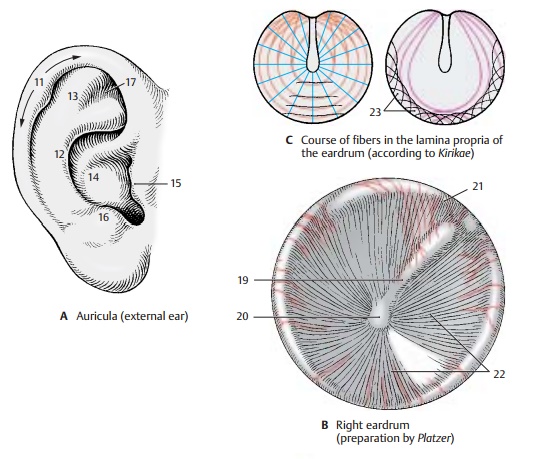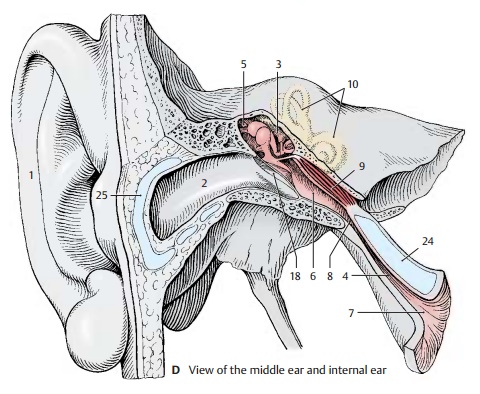Chapter: Human Nervous System and Sensory Organs : The Ear
Structure of The Ear
Structure of The
Ear
Overview (A, D)
The ear
contains two sensory organs with different functions; morphologically they form
a single complex, the inner ear, or ves-tibulocochlear
organ. One part of it, the cochlea,
is theorgan of hearing, or spiral organ (organ of Corti). The
other part con-sists of saccule, utricle, and semicircularducts; it registers changes in body position,especially
those of the head, and represents the organ
of balance, or vestibular appara-tus.
The ear is divided into three parts: the
external ear, the middle ear,
andthe internal ear.

The external ear includes the auricle (A, D1)
and the external acoustic meatus (D2).
The middle ear consists of the tympanic cav-ity(D3), the mastoid cells (air
cells), and the auditory tube
(eustachian tube) (D4). The tympanic
cavity with the auditory ossicles is a narrow space filled with air. It lies
behind the eardrum and extends as the epitympanic
recess (D5) above the
externalacoustic meatus. The tympanic cavity merges anteriorly into the
auditory tube (tympanic opening) (D6). The tube extends obliquely
downward and forward and opens in front of the posterior pharyngeal wall into
the pharyngeal cavity (pharyngealopening)
(D7). The auditory tube is linedwith
a ciliated epithelium and consists of an osseous and a cartilaginous section
that join at the isthmus of the tube
(D8). The tubal car-tilage(D24)
leaves open a cleft that is linedby connective tissue (membranous lamina). The tendon of the tensor tympani muscle
(D9) attaches to the base of the
manubrium of the malleus. The tympanic cavity communicates with the pharyngeal
cavity through the auditory tube, thus per-mitting exchange of air and the
equilibra-tion of pressure in the middle ear. The open-ing of the auditory
tube, however, is nor-mally closed and opens only when the pharyngeal muscles
contract (swallowing).
The internal ear consists of the bony
laby-rinth (D10), which contains the
mem-branous labyrinth and the internal acoustic meatus.

Related Topics